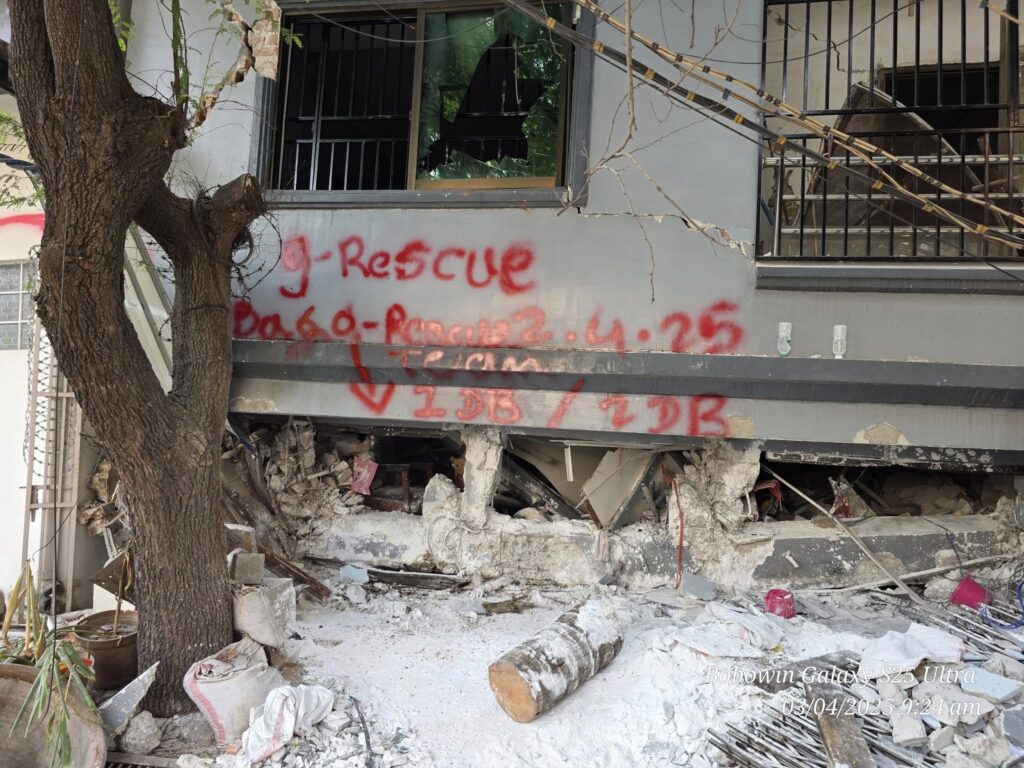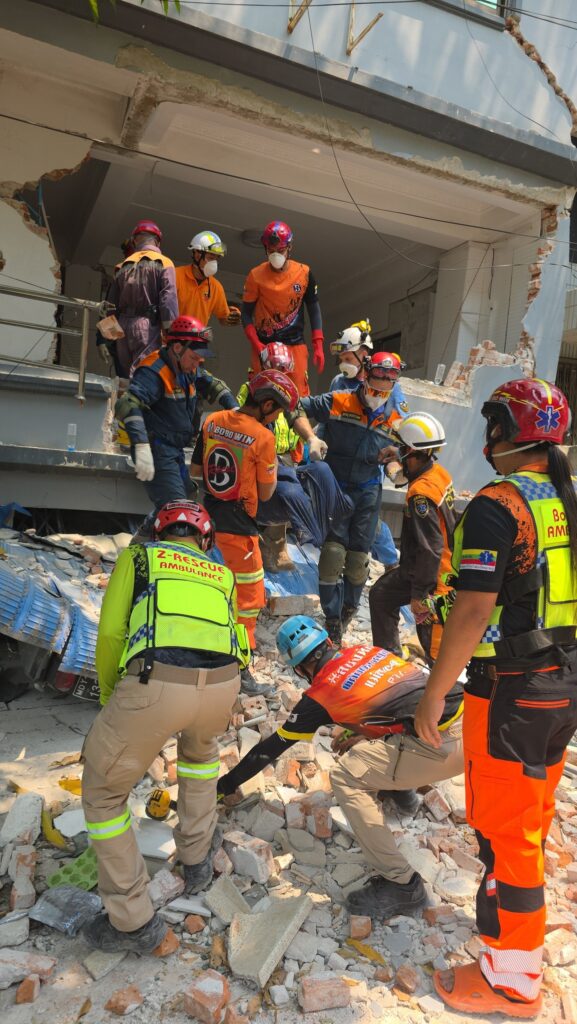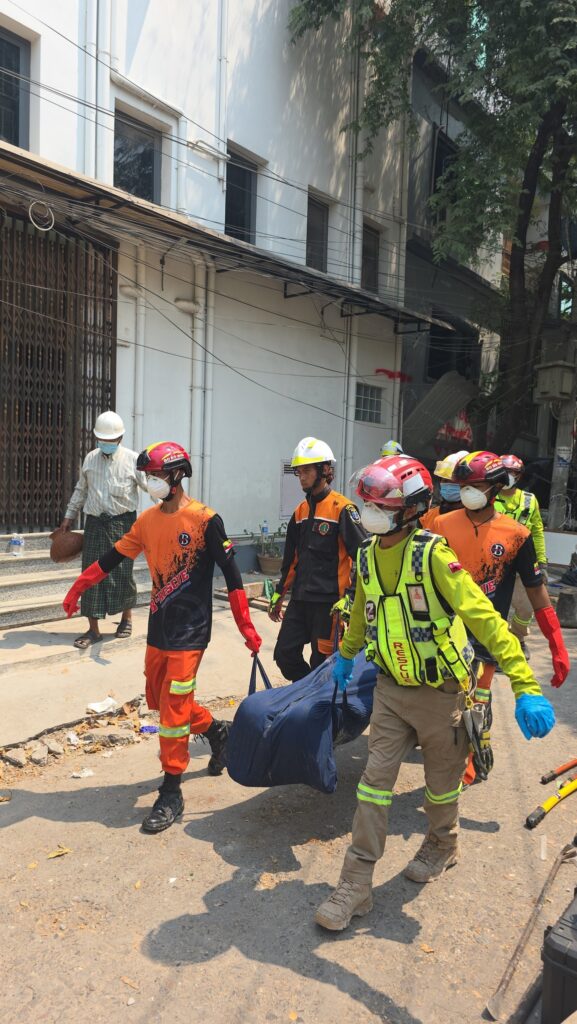It has been over ten days since the powerful earthquake struck Sagaing, Mandalay, and Naypyidaw regions, and rescue operations are continuing with increased momentum, according to local sources. However, as time goes on, rescue efforts are becoming increasingly difficult, say those on the ground assisting in the disaster zones.
With few survivors being found and operations now focused on clearing the bodies and human remains of the deceased, greater health protection measures are urgently needed for both rescuers and residents in the surrounding areas.
As of the morning of April 7, nearly 3,600 people have been confirmed dead, and over 100 are still missing nationwide due to the earthquake. Tremors continue to be felt daily.
We contacted a relief worker who traveled from Mon State to Mandalay to assist with earthquake rescue efforts to ask about the ongoing aftershock situation and the current rescue and relief operations needs.

Q: What is the current earthquake situation in Mandalay, where you and your team are carrying out rescue operations?
A: The ground still shakes almost every day, around magnitude 3.4, so it’s not too alarming, but when we recover dead bodies, there’s definitely risk involved. As people have said, Mandalay is now a flattened city, which is truly devastating. There aren’t even enough people to handle the situation.
Right now, we’re doing as much as we possibly can. At night, people all over the city sleep on the streets. There are still many places in desperate need of help. The situation is beyond what words can describe.
Q: Since aftershocks are still occurring, how are you managing the rescue operations under these conditions?
A: Because the ground keeps shaking daily, we must be extremely cautious during rescue operations. While some of us work inside the affected areas, others remain outside on standby, constantly monitoring the situation. If there’s any tremor, we immediately give signals and quickly evacuate. The ground shakes day and night—it just shook again a moment ago.

Q: As rescue operations have now been ongoing for an extended period, what kinds of difficulties are you facing?
A: Most of us involved in the rescue efforts anticipated this would be a long-term operation. That’s because, in some of the collapsed buildings, it’s extremely difficult to recover dead bodies. One of the main challenges is that we don’t have complete or proper rescue equipment. The smell from the bodies is getting worse, and due to the risk of disease, we have to wear masks constantly. We’re wearing masks all day long. The weather is hot, we’re sweating a lot, and people are getting physically exhausted.
Now that international organizations are starting to get involved, more care and attention are being given. But the longer this goes on, the more decomposition sets in, and the smell becomes unbearable for the rescuers. Medically, the risk of disease transmission is very high. There are bodily fluids everywhere, and the environment is getting more and more contaminated. We’ve had to constantly spray disinfectants and operate under those conditions.
In the earlier days, the focus was on urgently finding and rescuing survivors. Now that more time has passed, we must be more systematic in recovering bodies and protecting ourselves at the same time.
Q: What is currently needed both for rescue operations and for supporting those affected by the earthquake?
A: The main thing we need for rescue operations is proper rescue equipment. We don’t have enough machinery right now, making things really difficult. For example, the other day, there was a person trapped under the lower floor, but we didn’t have the complete set of demolition machines to get them out. The equipment we do have isn’t sufficient. We also can’t just demolish everything recklessly—if other people are still trapped, we risk hurting them. So we’re operating under very delicate conditions.
To stay safe, the rescuers need proper protective gear: thick gloves, sturdy boots, long-sleeved clothing, and hard helmets.
The most urgent needs for the survivors are drinking water, mosquito nets, bedding materials, and some clothing. In areas where homes were completely destroyed, funds are needed for equipment and general expenses. Some people are managing, but for those who’ve lost everything, financial support is absolutely essential.

Q: How much progress has been made so far in your rescue efforts?
A: The more complete and sufficient our rescue teams and equipment are, the more effectively and quickly we can assist. We’ve been working in areas across Mandalay and Sagaing, with many volunteers and relevant humanitarian organizations joining forces.
As for impact, whenever we reach a location, we work until the task is fully completed. But when looking at the whole city, there are still a few places we haven’t reached yet. In some locations, we’re facing delays because we lack enough machinery and manpower.
Q: Lastly, what message would you like to share with the public regarding the recent earthquake disaster affecting the entire country?
A: What I want to say about the earthquake is that all Myanmar citizens are standing in unity. Young people and charitable organizations are stepping up, setting aside their own interests to help out. Donations and support from the broader community are flowing in with solidarity, and seeing that gives strength to those working on the ground. Their contributions are truly impactful.
At the same time, many people online are spreading unnecessary comments. Not every news shared online is accurate—though many posts are genuinely shared out of urgent need, people should still carefully verify the information. I also want to urge people not to unnecessarily spread distress or negativity online.

